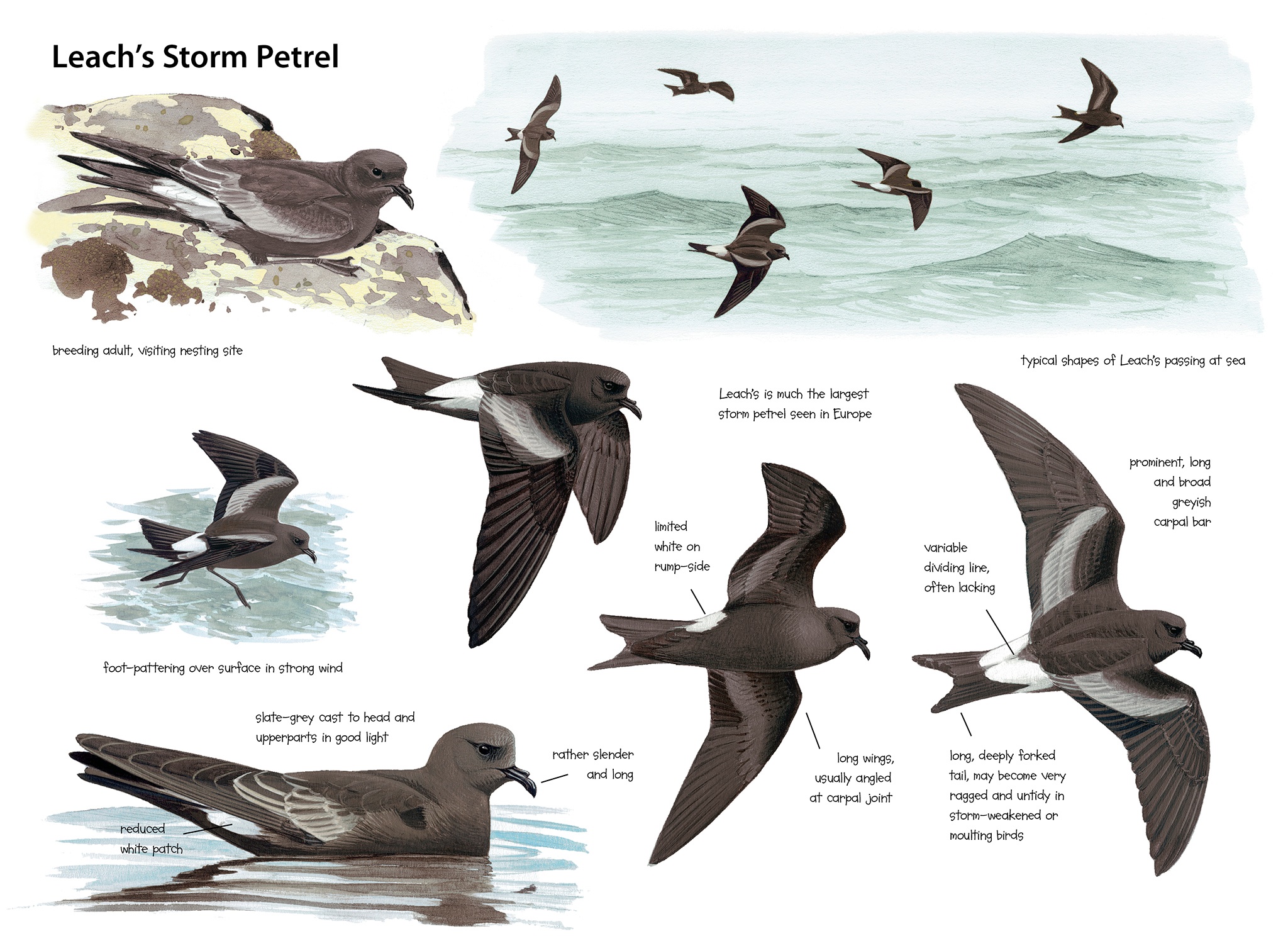
Killian Mullarney
Text by Magnus Robb
The Vestmannaeyjar off southern Iceland are of such recent volcanic origin that one of them, Surtsey, emerged from the sea as recently as November 1963. At the other end of the chain, the island closest to the Icelandic mainland seems to have been free of volcanic activity for quite some time. Elliðaey is old enough for countless burrows to have been excavated in its grassy slopes. These are only matched in number by the seabirds whizzing through the island’s lower airspace.
From the moment I jumped onto the rocks, the soundscape was dominated by the beating of thousands of wings, whirring rapidly in all directions at once. Northern Fulmars Fulmarus glacialis, Common Murres Uria aalge and Razorbills Alca torda crowded together on the island’s perimeter cliffs. However, almost all of the wings that whirred to and fro over the top of the island belonged to Atlantic Puffins Fratercula arctica. They kept flying past even when the sun set at 23:00, and the light dimmed for a few hours. Around midnight, a dense layer of fast moving, sharp chatters was gradually added to the mix. Thousands of Leach’s Storm Petrels Oceanodroma leucorhoa were returning from the sea.
Between them, Leach’s Storm Petrels and Atlantic Puffins have undermined the grassy surface of Elliðaey to such an extent that, to avoid damaging burrows or breaking a leg, you have to move slowly and carefully at all times. The density of burrows is highest where the ground is more sloping, especially towards the middle of the island. This is because puffins can take off more easily there, and presumably also because the drainage is better. In CD2-29, you can hear a typical scene on one of these slopes. The motorbikes revving on either side are puffins, and the demonic chucklers darting about above them are displaying Leach’s. From an acoustic point of view, these species are the perfect neighbours, because they use quite different frequency bands. The low pitched puffins barely overlap with the shrill Leach’s chatters, so there is no competition for the airwaves.
CD2-29: Leach’s Storm Petrel Oceanodroma leucorhoa and Atlantic Puffin Fratercula arctica, Elliðaey, Vestmannaeyjar, Iceland, 01:00, 19 July 2003. Neighbouring Atlantic Puffins call from burrows on either side, while Leach’s Storm Petrels display in flight overhead. 03.033.MR.13058.01
In the mid-1930s, two young men from Oxford, England, John Ainslie and Robert Atkinson, were looking for a bird species to study that would involve a bit of adventure. The ‘Leach’s Fork-tailed Petrel’ they found in the index of a contemporary bird book seemed to be just the thing. To heighten the adventure, they decided not to study this species on its most famous Scottish outpost, St Kilda, but on North Rona, 71 km north north-east of Lewis in the Outer Hebrides, an island that had rarely been visited by ornithologists up to that time. The difficulties involved in getting there, as well as their later visits to several other remote Scottish islands, are recounted in an entertaining book called ‘Island going’ (Atkinson 1949), which is a must read for all petrel fans.
From 16 July to 12 August 1936, Ainslie and Atkinson had North Rona to themselves. The island had been uninhabited for all but a year or two since 1844. But the two young men were not alone. The walls of the old ruins where they set up camp trilled to the sound of both British Storm Petrels Hydrobates pelagicus and Leach’s Storm Petrels. One of the chapters in Atkinson’s book is titled ‘A dull calm night’, and in it, he explains that maximum activity occurred on such nights, not just for Leach’s displaying over the colony, but also for ornithologists.
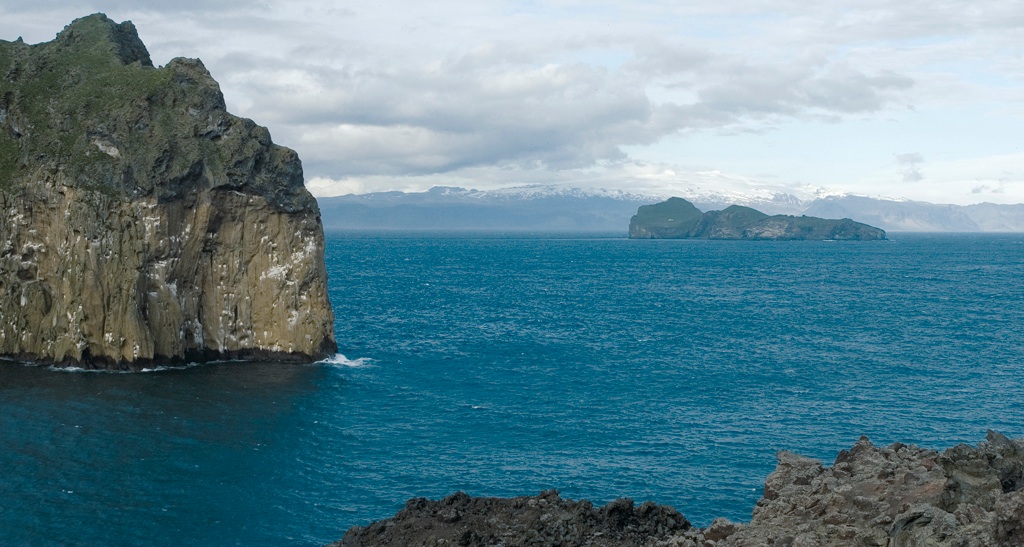
Elliðaey seen from Heimaey, Vestmannaeyjar, Iceland, June 2006 (Jacob Gonzáles-Solís). CD2-29 to CD2-32 and CD2-37 to CD2-39 were recorded on Elliðaey.
On their first night of field work, Atkinson stood in the ruins of an ancient chapel and just savoured the experience. I love his description of Leach’s Storm Petrel’s display flight: “The weird things darted and fluttered round – close to the ground – sweeping up against the sky – turning and twisting and going at breakneck speed… The little birds began to call. The sharp cries, loud and uncouth, came faster, tumbling over each other, more and more. The activity of dashing and shouting worked up to a pitch and sustained it full tilt – eccentric, abandoned aviary in the night above the village.” I think CD2-30 illustrates this rather well.
CD2-30: Leach’s Storm Petrel Oceanodroma leucorhoa, Elliðaey, Vestmannaeyjar, Iceland, 01:45, 20 July 2003. Chatter calls of thousands, both male and female, in the twilight that is an Icelandic summer night. At the same time, wingbeats and a few distant calls of Atlantic Puffins Fratercula arctica can be heard. 03.034.MR.12402.01
The fact that Leach’s Storm Petrel is highly vocal in flight puts it in stark contrast to British Storm Petrel, whose calls in flight are weak and easily missed. In each species, chatter calls are given by both sexes, but only in Leach’s do we know how to tell the difference. Female Leach’s average lower pitched than males, and tend to have more notes at the end. However, the only way to tell them apart with certainty is by listening to the low note in the middle of the call. In Japan at least, this has a peak fundamental frequency above 800 Hz in males, and below 750 Hz in females (Taoka et al 1989b). To my ears, Leach’s in Japanese recordings (eg, Ueda 1998) sound identical to North Atlantic ones and I think that, perhaps with the odd exception, we can sex most of our birds in the same way.
As with so many bird sounds, the meaning of Leach’s Storm Petrel chatter calls varies enormously according to context. When Taoka et al (1989a) broadcasted chatter calls of either sex just outside a breeding colony, birds that responded from the air were always of the opposite sex. So in the context of ground to air calling, chatter calls are sexually attractive. However, when the researchers broadcasted male or female chatter calls into a burrow, responses came from birds of the same sex. From inside their burrow, same sex occupants interpreted chatter calls as an act of aggression, and chattered back to reassert their occupancy.
I performed no playback experiments myself, but to simulate an intrusion it was enough to fidget with some grass at the entrance to a burrow. In CD2-31, you can hear a male and two of his neighbours responding. An example of a female giving her lower pitched chatter calls from a burrow can be heard in CD2-32.
CD2-31: Leach’s Storm Petrel Oceanodroma leucorhoa, Elliðaey, Vestmannaeyjar, Iceland, 02:00, 19 July 2003. Male chatter calls and a rising wheeze, which resembles the breath note from purring. In this context, both are aggressive signals, and responses can be heard from two neighbouring males. Background: wingbeats of Atlantic Puffins Fratercula arctica. 03.034.MR.00427.21
CD2-32: Leach’s Storm Petrel Oceanodroma leucorhoa, Elliðaey, Vestmannaeyjar, Iceland, 01:00, 19 July 2003. Chatter calls and short bursts of purring from a female. Background: calls and wingbeats of Atlantic Puffins Fratercula arctica. 03.033.MR.12301.01
At the start of the 21st century, the St Kilda archipelago in Scotland was estimated to hold 45 433 occupied burrows belonging to Leach’s Storm Petrels (Mitchell et al 2004). The largest island Hirta held 3605, most of which were found on the steep slopes of Carn Mór, where burrows are excavated under huge, lichen-covered boulders or under the grass between them. Atlantic Puffins breed in huge numbers there too, but during my visit in the summer of 2007, only the petrels were active at night. Northern Fulmars could be heard from the cliffs above and a few British Storm Petrels purred at the periphery of the boulder field. Leach’s flitted about in the sky, where they were outnumbered by thousands of Manx Shearwaters Puffinus puffinus.
Earlier in the summer, chatter calls of Leach’s Storm Petrels might have overpowered the Manx Shearwaters, but by late July, incubation was coming to an end and the peak of vocal activity had already passed. Nevertheless, Peter Nuyten and I probably heard most of the adult repertoire of Leach’s during the two nights we spent in the colony. In many burrows, birds could be heard purring, a sound similar to its equivalent in British Storm Petrel. Leach’s sound altogether more laid back, however, as their purring is much slower. At three seconds long, their breathing cycle is about twice the length of that of British.
In Leach’s Storm Petrel, unlike British Storm Petrel, both sexes purr. Typically, purring is heard when male and female are present together in a burrow, before they have eggs or young (Taoka et al 1988). During our visits most birds purring would have been ones that had not yet reached breeding age.
When a pair of Leach’s are purring together, you can tell the male and female apart. I began to work this out while listening to Leach’s on St Kilda. By listening carefully to chatter calls, I was able to sex the birds and check for any differences between male and female purring. My hearing is not infallible, so I consulted sonagrams when I got home. When I compared the purring of six males and six females, some clear differences began to emerge.
Rhythm and timing is essentially the same in both sexes, and the differences all have to do with pitch. A male can be heard in CD2-33, and a female in CD2-34. The purring part of each breath cycle is higher pitched in males than in females. You can hear this most easily in the accented note at the start of the purring, just after the breath note, which in my sample averaged 37% higher in males than in females. In males, the purring then rises more in pitch towards the end than it does in females. Curiously, however, the breath note tends to be higher in females, not males. It follows that females show more pitch contrast between their higher breath note and lower purring. This is most audible in the drop from the end of the breath note to the accented start of the purring. In males, the corresponding drop in frequency averaged four times smaller.
CD2-33: Leach’s Storm Petrel Oceanodroma leucorhoa, Hirta, St Kilda, Western Isles, Scotland, 03:06, 24 July 2007. Purring of a male. Background: Manx Shearwater Puffinus puffinus. 070724.MR.030637.00
CD2-34: Leach’s Storm Petrel Oceanodroma leucorhoa, Hirta, St Kilda, Western Isles, Scotland, 01:51, 23 July 2003. Purring of a female, becoming fainter as she moves deeper into the burrow. A male chatter call can be heard at 0:14. Background: Manx Shearwater Puffinus puffinus. 070723.MR.015102.01
Now listen to a male and female purring together, following a chatter call of each at the start (CD2-35). The lower female starts slightly ahead but the higher male follows almost immediately. When they are purring together, you can hear that the low pitch of the female’s accented notes is the best way to pick her out, especially when, as in this recording, her breath notes are not always higher pitched than the male’s. The purring of the two birds in the recording moves in and out of phase, and there are some curious effects as this happens (eg, at 0:58).
CD2-35: Leach’s Storm Petrel Oceanodroma leucorhoa, Hirta, St Kilda, Western Isles, Scotland, 02:17, 24 July 2007. Chatter calls and purring of a female and male together in the same burrow. In this case, the female calls first, both in the chatter call at the start and the purring that follows. Background: Manx Shearwater Puffinus puffinus. 070724.MR.021706.00
Very rarely, purring can be heard in flight. I have never heard this myself, but Peter recorded an example during our stay on St Kilda. CD2-36 starts with a chatter call from a female in flight, followed by a rising breath note and a short purring sound. The purring bird is flying from centre to right in the stereo picture at 0:03. Judging from its high pitch, the caller is probably a male. A female in a nearby burrow reacts with a loud chatter call and some purring. The significance of purring in flight is unknown, but in this case I believe that it formed part of an interaction between the male and the two females.
CD2-36: Leach’s Storm Petrel Oceanodroma leucorhoa, Hirta, St Kilda, Western Isles, Scotland, 02:04, 23 July 2007. Brief snatch of aerial purring by a male. The chatter calls before and after it are given by two females: the first in flight and the second in a burrow. Background: Manx Shearwater Puffinus puffinus. Peter Nuyten.
As with other storm petrels, little is known about calls of Leach’s at sea, and only chatter calls have been reported. On several nights between 3 and 20 November, Leach’s were attracted to the powerful floodlights of a stationary research ship in deep waters south of Madeira (Wynn 2005). It is not known why these birds were attracted to the ship, or what stimulated them to call. Calling in bright floodlights seems to contradict what we know about petrels preferring dark nights. Perhaps the risk of predation is negligible so far from the shore.
Aggressive calls exist in the repertoires of most storm petrels on land and some are probably used at sea too. In Leach’s Storm Petrel, aggressive signals include chatter calls as well as a rising wheeze, which resembles the breath note from purring. Perhaps their most aggressive signal is the so-called screech call, which can also be heard when Leach’s are handled. In CD2-37, you can hear all three aggressive signals from a male who was reacting to the arrival of an intruder. In CD2-38, a furious Leach’s gives screech calls from the hand of a ringer.
CD2-37: Leach’s Storm Petrel Oceanodroma leucorhoa, Elliðaey, Vestmannaeyjar, Iceland, 02:00, 19 July 2003. Chatter, wheeze and screech calls of a male, responding to the arrival of an intruder. Background: a very young nestling. 03.034.MR.00004c.01
CD2-38: Leach’s Storm Petrel Oceanodroma leucorhoa, Elliðaey, Vestmannaeyjar, Iceland, 12:00, 19 July 2003. Screech calls of an individual in the hand. 03.034.MR.00823.01
One of the Icelanders on Elliðaey during my visit was Jóhann Óli Hilmarsson who, on 31 July 1988, was a member of the first Western Palearctic ringing team ever to catch a Wilson’s Storm Petrel in a mist net (Hilmarsson & Hansen 1989). On that occasion, Jóhann Óli was on Bjarnarey, another of the Vestmannaeyjar. Wilson’s usually only visits land from November to May, so perhaps this Southern Hemisphere storm petrel had somehow got its hormones out of sync. It was trapped on a night of strong moonlight, at a time of night when the only Leach’s Storm Petrels arriving were breeders feeding their young. Unfortunately, the Wilson’s died while being held in captivity overnight. It had a fully vascularised brood patch. When dissected it turned out to be a female, and there were indications that it had bred before. It remains uncertain whether it had bred on Bjarnarey, and whether it was paired with a member of its own species. No more Wilson’s were found in Iceland until 11 August 2007, when a moulting bird was watched very well for nearly an hour, about 21 miles south of the Vestmannaeyjar.
Famously, one or two Black-browed Albatrosses Thalassarche melanophris have committed the same ‘error’, making themselves at home among Northern Gannets Morus bassanus in Scotland and the Faeroes. ‘Out-of-hemisphere experiences’ can also happen the other way round, with northern species appearing at breeding sites in the far south. In November 1980, two Leach’s Storm Petrels were found calling in flight and prospecting burrows on Rabbit Island in the Chatham Islands, about 800 km east of Christchurch, New Zealand (Imber & Lovegrove 1982). More recently, Leach’s have bred on Dyer Island, South Africa, and possibly on nearby Dassen and Jutten Islands (Whittington et al 1999, 2001).
Most Leach’s Storm Petrels, of course, breed on offshore islands in the Northern Hemisphere. European populations include about 48 000 pairs on seven remote Scotland islands or archipelagos and about 300 pairs on the inaccessible Stags of Broadhaven in Mayo, Ireland (Mitchell et al 2004). The Icelandic population is estimated at 90 000 pairs, and there are about 1000 in the Faeroes and 100-1000 pairs in Norway (Anker-Nilssen et al 2000, Brooke 2004). European populations pale to insignificance when compared to the numbers breeding on the other side of the Atlantic. Almost 5 million pairs are thought to breed in the Maritime States of Canada, with another 20 000 or so in New England (Huntington et al 1996). The largest single colony, with about 70% of the West Atlantic population and 40% of the estimated world population, is located on Baccalieu Island, Newfoundland, which is only 5 km2 in size. Another colony on Kent Island, New Brunswick, is located among spruce forest, surely making it more difficult for the petrels to locate their nests.
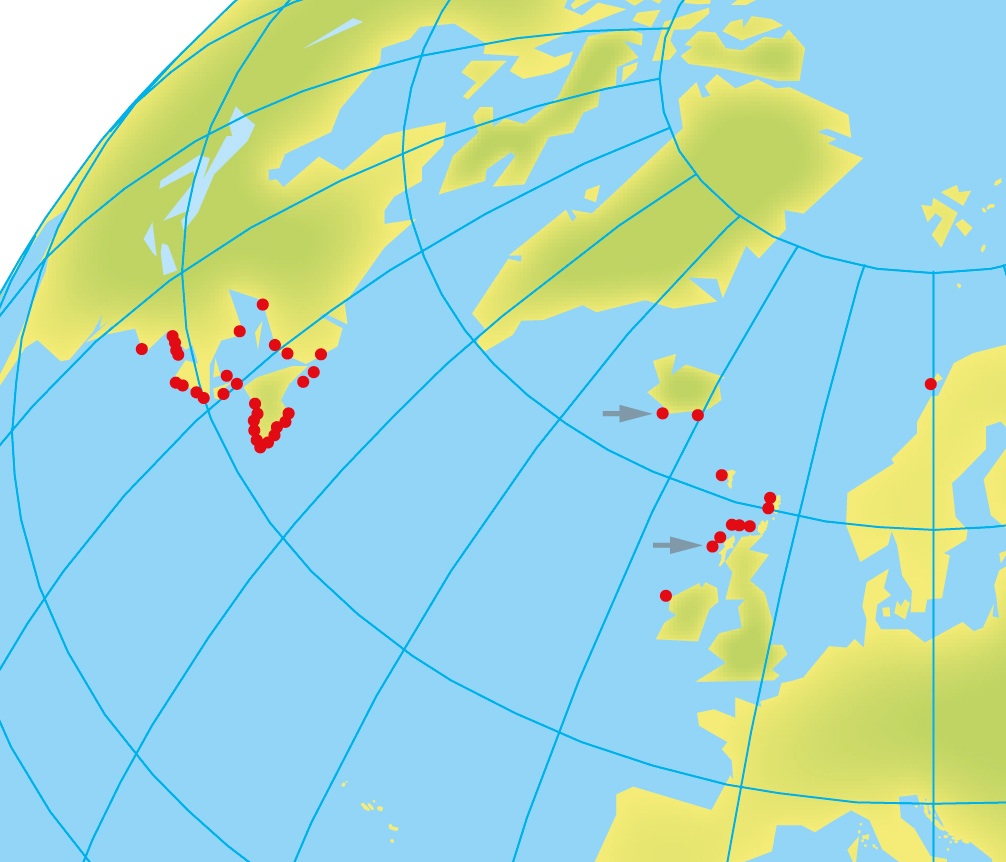
Leach’s Storm Petrel Oceanodroma leucorhoa: known North Atlantic breeding distribution. Recording locations indicated by arrows (north to south):
Elliðaey, Vestmannaeyjar, Iceland; St Kilda, Western Isles, Scotland.
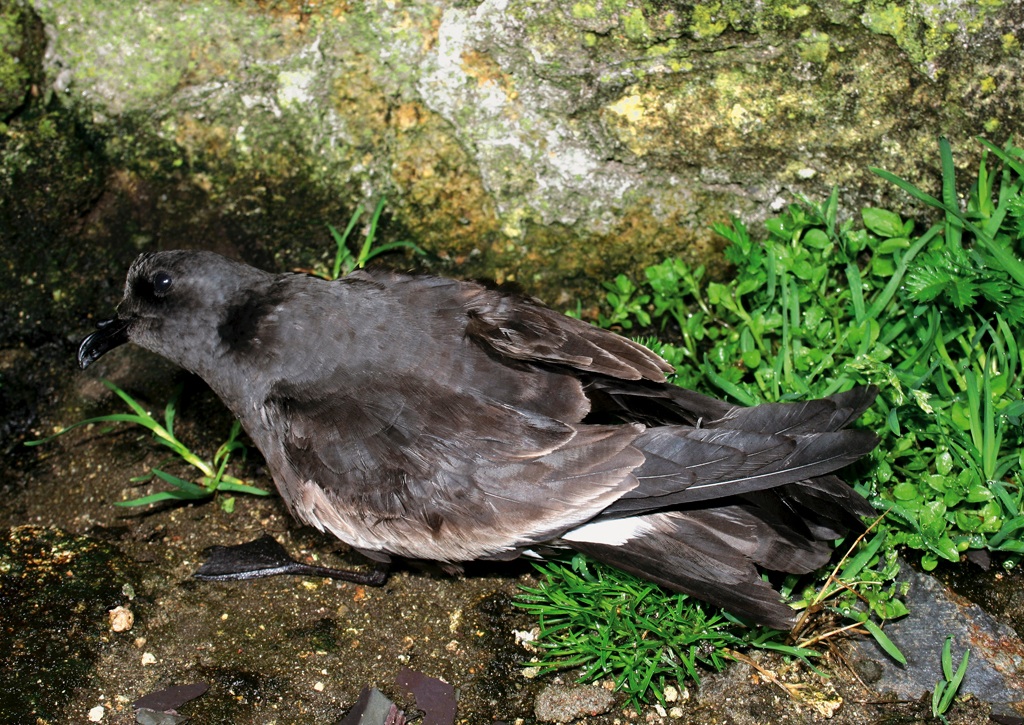
Leach’s Storm Petrel Oceanodroma leucorhoa, St Kilda, Western Isles, Scotland, 28 June 2005 (Mark Bolton). This bird was photographed in the same colony where CD2-33 to CD2-36 were recorded.
Back in the 1960s, seven Leach’s taken from Kent Island faced a much greater challenge getting back home. They were taken across the Atlantic to Selsey Bill, Sussex, England, and released as part of a homing experiment. The fastest two birds were back at their burrows 13.7 days later, having flown 4800 km back across the ocean, an average of 350 km per day (Billings 1968). By the time the birds reached their burrows, their exceedingly hungry young nestlings would have greeted them with intense begging calls, if indeed they were still alive.
Leach’s Storm Petrel’s nestlings have a rhythmic begging call similar to that of other petrels and shearwaters, and they also have two other calls in their repertoire (Naugler & Smith 1992). The ‘short call’ is given in response to non-tactile disturbances, such as when a stranger enters the burrow, or a researcher causes disturbance outside. I have never knowingly heard it myself. The ‘high call’ is heard when nestlings are handled or otherwise physically disturbed, and it seems to be an early version of the adult screech call. It becomes differentiated from the rhythmic begging call within the first week of life. In CD2-39, you can hear high calls caused by an unknown disturbance, followed by rhythmic begging of the same and a neighbouring nestling. Judging from precisely aged sonagrams published in Naugler & Smith (1992), the high calls in CD2-39 are not quite fully developed, so the nestling that produced them was probably less than a week old.
CD2-39: Leach’s Storm Petrel Oceanodroma leucorhoa, Elliðaey, Vestmannaeyjar, Iceland, 02:00, 19 July 2003. Calls of two very young nestlings. Four high calls at the start, then rhythmic begging calls of both nestlings can be heard. Background: adults, and calls and wingbeats of Atlantic Puffins Fratercula arctica. 03.033.MR.15504.00
Most nestling Leach’s Storm Petrels in the Atlantic fledge between about mid-September and late October (Huntingdon et al 1996), with the exception of Arctic breeders in Norway that probably do not fledge until early December. Autumn is the time when most ‘wrecks’ of Leach’s take place, and a great many of the birds involved in these are undoubtedly juveniles. In less extreme weather conditions too, many of the Leach’s that delight seawatchers in autumn are probably juveniles only a week or two out of the nest.
Many North American Leach’s Storm Petrels are thought to migrate east to European waters after the end of the breeding season. The 300 000 to 2 million Leach’s estimated to occur in the Bay of Biscay and adjacent waters in autumn amount to many times more than the eastern Atlantic population (Hémery & Jouanin 1988). A one-year-old from Kent Island found in north-western France in January 1988 and a juvenile from Gull Island, Newfoundland, found in north-western Spain in January 1963 provide evidence by ringing recoveries that some immature Leach’s from Canada winter in European seas (Huntington et al 1996).
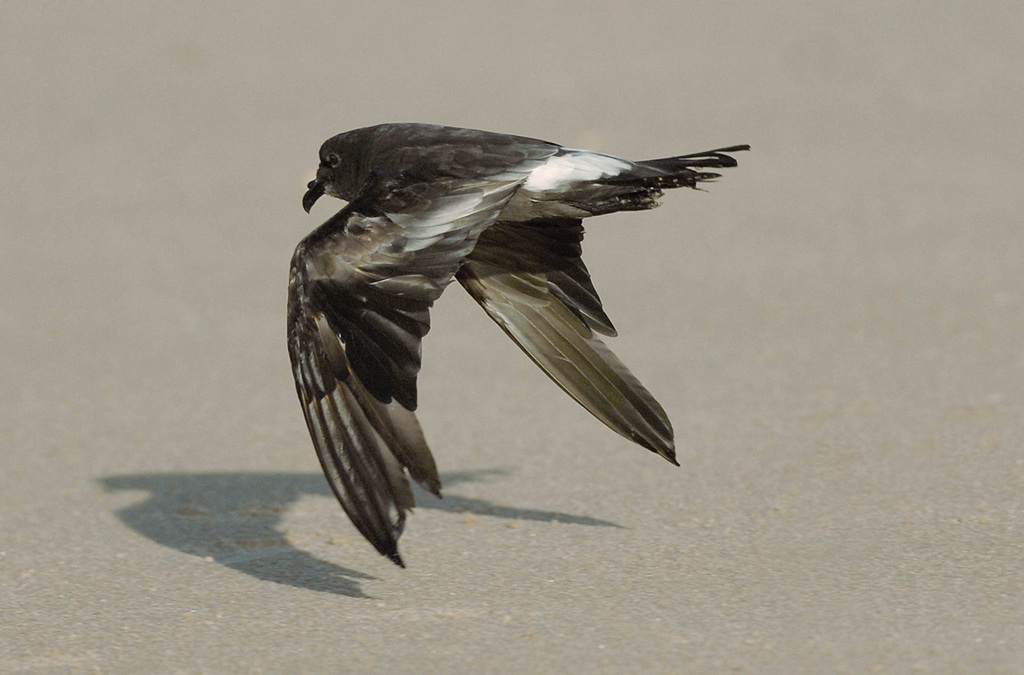
Leach’s Storm Petrel Oceanodroma leucorhoa, Crosby, Merseyside, England, December 2006 (Steve Young)
The type specimen of Leach’s Storm Petrel, obtained on the coast of Picardy, northern France, may well have been a North American bird. It came into the hands of Louis Vieillot, a prolific writer and describer of new species, who named it leucorhoa, based on Greek words for ‘white’ and ‘rump’, in 1817. Two years later, the news had apparently not reached Coenraad Jacob Temminck, who lost out when a specimen of an unfamiliar storm petrel collected on St Kilda went to auction in London, England. The petrel had found its way into the collection of William Bullock, and when Bullock auctioned his collection in 1819, famous ornithologists from all over Europe turned up, also including Bonelli and Lichtenstein. The man who successfully bid £5 15s for the petrel was one William Elford Leach, an assistant librarian from the British Museum, better known in his day as a specialist in crustaceans and molluscs. Temminck honoured Leach when he described the ‘new’ species in 1820. When it transpired that Vieillot had beat him to it, Temminck’s scientific name was dropped, but the name Leach will forever be associated with this species in the English speaking world (Mearns & Mearns 1988).
Leach’s Storm Petrels in northern parts of the Pacific look, sound and measure very much the same as Atlantic ones, and they are usually considered to belong to the same taxon. The further south you travel along the North American west coast, the more different Leach’s become. The most striking variation is that some have an all-dark rump, a feature almost unknown in the Atlantic. On the San Benito and Los Coronados Islands not far off Mexico’s Baja California peninsula there is a dark-rumped population sometimes separated as chapmani, which has a slightly more rounded wing and a slightly deeper notch to the tail fork. Sonagrams show that its calls are not markedly different from those of Atlantic and North Pacific leucorhoa (Ainley 1980, 1983, Power & Ainley 1986).
It is on Guadalupe that things really begin to get interesting. This Mexican island, 241 km west of the Baja California peninsula, was once home to the endemic Guadalupe Storm Petrel O macrodactyla, last known to have bred in 1912. It still has two endemic storm petrels that are traditionally included in Leach’s Storm Petrel. Summer-breeding socorroensis is the smallest of all ‘Leach’s’ and comes in both dark-rumped and white-rumped morphs. Winter-breeding cheimomnestes has a distinctly longer bill, tail and tarsus and more pointed wings, and always has at least some white in the rump. Chatter calls of these two seasonal populations are mutually distinct, although their purring is similar. In both chatter calls and purring, however, they differ markedly from chapmani and leucorhoa (Ainley 1980). It is hard to understand why they have not been elevated to species status, like Swinhoe’s Storm Petrel O monorhis, another former subspecies of Leach’s. Guadalupe is beyond the geographical scope of this book. However, as you will learn, there are equally fascinating, seasonally distinct storm petrels much closer to home.
